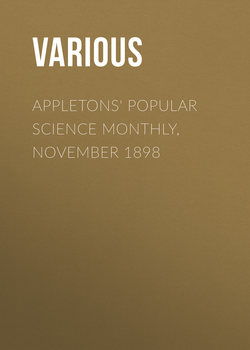Appletons' Popular Science Monthly, November 1898

Реклама. ООО «ЛитРес», ИНН: 7719571260.
Оглавление
Various. Appletons' Popular Science Monthly, November 1898
WAS MIDDLE AMERICA PEOPLED FROM ASIA?
THE POSSIBLE FIBER INDUSTRIES OF THE UNITED STATES
WHAT IS SOCIAL EVOLUTION?
THE TORRENTS OF SWITZERLAND
THE EVOLUTION OF COLONIES
ARCHITECTURAL FORMS IN NATURE
THE HERDS OF THE YELLOW ANT
TWO GIFTS TO FRENCH SCIENCE
THE MONGOOSE IN JAMAICA
THE CAUSE OF RAIN.[12]
DREAM AND REALITY
A PRACTICAL DUTCH CHARITY
SKETCH OF FRANK WIGGLESWORTH CLARKE
Correspondence
Editor's Table
Scientific Literature
GENERAL NOTICES
PUBLICATIONS RECEIVED
Fragments of Science
MINOR PARAGRAPHS
Отрывок из книги
The wealth of any community is dependent on the variety and extent of its industries, the utilization of local natural resources, and the employment of the labor of all classes of its population. In locations of successful industrial operations the farmer derives increased incomes, the value of his products is greater, his lands of higher value, and the wages of agricultural labor larger. The rural population contiguous to large towns, therefore, is more prosperous than the larger farming contingent more remote from manufacturing or industrial centers. The farmers of the first class are prosperous because they have a home market for their dairy products, fruits, vegetables, and other "truck," which they are able to produce, for the most part, on small areas by high culture, while those of the second class are forced to expend their energies on commercial commodities such as cotton, wool, meat, grain, etc., with long hauls in transportation, and with heavy competition, international as well as domestic.
In times of depression, or when competition has grown too heavy, the cultivation of certain staples may cease to be remunerative, and the unfortunate producer is compelled to diversify his agriculture, or adopt some other means of livelihood.
.....
The world's interest in this fiber began in 1869, when a reward of five thousand pounds was offered by the Government of India for the best machine with which to decorticate the green stalks. The first exhibition and trial of machines took place in 1872, resulting in utter failure. The reward was again offered, and in 1879 a second official trial was held, at which ten machines competed, though none filled the requirements, and subsequently the offer was withdrawn. The immediate result was to stimulate invention in many countries, and from 1869 to the present time inventors have been untiring in their efforts to produce a successful machine. The commercial history of ramie, therefore, does not extend further back than 1869.
The first French official trials took place in 1888, followed by the trials of 1889, in Paris, at which the writer was present, and which are recorded in the official reports of the Fiber Investigation series. Another trial was held in 1891, and in the same year the first official trials in America took place, in the State of Vera Cruz, in Mexico, followed the next year by the official trials of American machines in the United States, these being followed by the trials of 1894. Since that year further progress in machine construction has been made, and a third official trial should be held in the near future.
.....